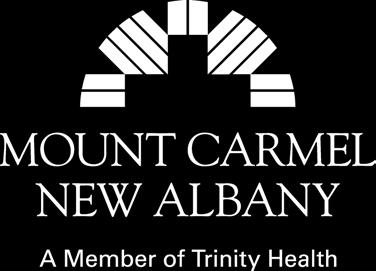Leading Wellness






Charles Dankworth, CFP® , CIMA®, CPWA® Senior Vice President–Wealth Management
Patrick Clark, CFP® Team Administrator
New Albany Wealth Partners UBS Financial Services Inc. 180 Market Street, Suite 200 New Albany, OH 43054 614-939-2202 newalbanywealthpartners@ubs.com
Romeo Vuticevski, CRPS® Senior Vice President–Wealth Management
Courtney Freed Registered Client Associate
advisors.ubs.com/newalbanywealthpartners
Kevin Snead, CFA Account Vice President
Amy Baker Client Associate












Phil Heit Executive Editor
Kathleen K. Gill
Gianna Barrett
Dave Prosser
Gary Hoffman
Christy Smiley
Megan Brokamp, Jane Dimel, Ella Jay, Rachel Karas
Katie Allen, Elizabeth Cullinan, Dylan Telerski
Elise Conrad, Avery Gillis, Disha Hoque, Maxwell Knauer
Rae Moro, Laura Pappas
CEO
President
Chief Creative Officer
Creative Director
Business/Office Manager
Editors
Contributing Writers
Editorial Assistants
Media & Marketing Advisors







Darrin Bright, M.D.
Michael Sawyers
Lisa Hinson
Benita Jackson, M.D., M.P.H.
Craig Mohre
David Sabgir, M.D.
Hinson Ltd. Public Relations
Guidewell Source
New Albany Community Foundation
OhioHealth


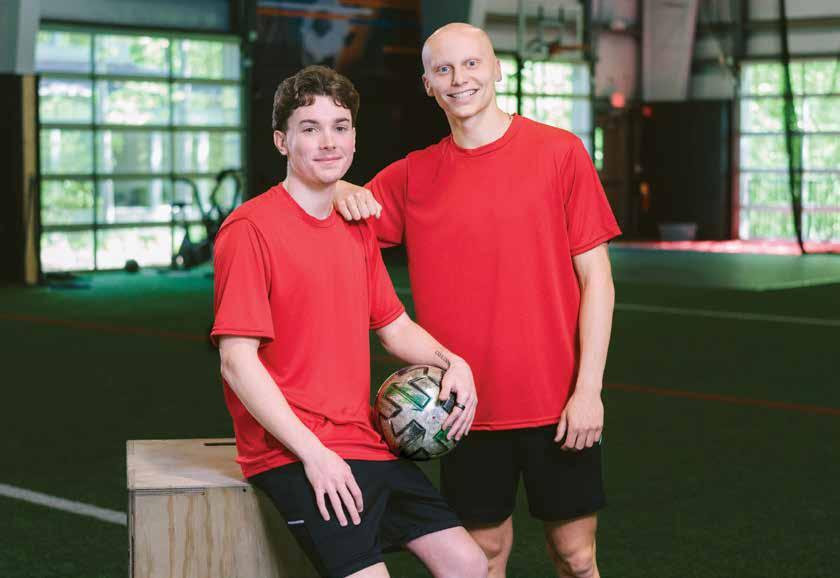
Both Division I college soccer players, Andre and Ashton know how important it is to partner with a sports medicine team that understands what it means to be an athlete, and more importantly, a soccer player. Both grew up playing in central Ohio and dreamed of putting on the scarlet and gray. Throughout their careers, they’ve trusted Orthopedic One to help them return to the pitch following injuries or setbacks.
Watch their story.





Until a year ago, I would have considered myself summa cum laude if there was such a designation for fitness. Correlated to academic terms, my fitness ability achieved the highest level of distinction.
My elevated level of fitness would have been validated based upon several of the articles in this issue which noted various components of a well-rounded workout such as ways to maximize miles, how to strengthen one’s stride and post-race recovery advice.
After reviewing these articles and reflecting on my previous walking and running regimens, it became clear that my fitness level as well as the medical advice emphasized in the fitness literature were often void of one major component. That is, the importance of strength training to overall well-being.
Let me be succinct. If you do strength training, you will live longer and better. Yes, I am bold in taking such a position but the facts support my premise. Up until a year ago, strength training was not a component of my workout regime. I considered my cardio workouts to be more than adequate toward achieving a well-rounded level of good health.
A recent study published in The British Journal of Sports Medicine found that doing aerobic exercise or strength training correlated with a lower risk of dying during the time of the study. But when regularly doing both, the risk of dying was even lower.
More studies are now being published that stress the importance of strength training. Consider that once you reach your mid 30’s, you lose muscle mass. With strength training, you can reduce loss of muscle mass and conversely gain muscle function. In fact, many studies now show that regular strength training combined with aerobic exercise positively impact longevity as well as the risk of death from cancer, diabetes and heart disease.
The Department of Health and Human Services recommends 150 minutes of moderate aerobic activity and strength training two times per week. I can attest to the difference that adding strength training to my workouts has made. I am stronger and feel better.
And you don’t need a gym membership to reap the benefits strength training brings. On a recent trip, I packed resistance
bands and when possible, used them in lieu of weights. I used the bands to increase hip function, core strength and when I returned to the gym, I experienced an increase in the number of reps I was able to complete on various pieces of equipment. Of course, if you have access to a fitness facility, and there are many choices in New Albany, take advantage of the opportunity.
Stay strong, Phil Executive Editor

Wednesdays
Walk with a Doc
9 a.m.
Coffman Park
5200 Emerald Pkwy., Dublin www.walkwithadoc.org
Fri., Sept. 5
Oktoberfest Meiler Vier
6:15 p.m.
Ohio Expo Center
717 E. 17th Ave., Columbus www.m3ssports.com
Fri., Sept. 5
Bernstein in Story and Song presented by the New Albany Symphony
7:30-9:30 p.m.
Hinson Amphitheater
170 E. Dublin Granville Rd. www.newalbanysymphony.com
Sat., Sept. 6
Sensory Friendly Concerts: Dancing in the Streets presented by the New Albany Symphony
11:30 a.m.-12:30 p.m.
Jeanne B. McCoy Community Center for the Arts
100 E. Dublin Granville Rd. www.newalbanysymphony.com

Music Festival
Sun., Sept. 7
New Albany Walking Classic
8 a.m.
Starting line: Market Square 200 Market St. www.healthynewalbany.org
Sat., Sept. 13
Artist Opening Reception: Unsupervised Destinations
5-8 p.m.
Hayley Gallery
260 Market St. www.localohioart.com

Fri., Sept. 19
The Challenge Music Festival
5-11 p.m.
A&F Co. Global Home Office 6301 Fitch Path Rd. www.anfchallenge.org
Sun., Sept. 21
Columbus Clippers 5K 9:30 a.m.
Huntington Park 330 Huntington Park Ln., Columbus www.clippers5k.com
Sun., Sept. 21
DogFest North Central
1-4 p.m.
Canine Companion North Central Training Center 7480 New Albany Condit Rd. www.canine.org

New Albany Walking Club meets Sundays at 7:30 a.m. inside the Philip Heit Center. www.newalbanywalkingclub.com



Fri., Sept. 26
New Albany Parks and Recreation Foundation Golf Outing
9 a.m.
New Albany Links Golf Club
7100 New Albany Links Dr. www.facebook.com
Sat., Sept. 27
9th Annual Speak! Golf Scramble
7:30 a.m.-2:30 p.m.
New Albany Links Golf Club
7100 New Albany Links Dr. www.speakfortheunspoken.com
www.healthynewalbanymagazine.com
Sun., Sept. 28
New Albany Community Foundation Fall
Family Music Fest
2 p.m.
Charleen & Charles Hinson
Amphitheater
170 E. Dublin Granville Rd. www.newalbanyfoundation.org
Sat., Oct. 4
Oktoberfest
Noon-4 p.m.
Rose Run Park Fodor Rd. www.newalbanyohio.org
Thurs., Oct. 9
The New Albany Community Foundation presents The New Albany Lecture Series: Health & Wellbeing, Robin Roberts interviewed by Doug Ulman
Jeanne B. McCoy Community Center for the Arts
100 E. Dublin Granville Rd. www.newalbanyfoundation.org
Sun., Oct. 12
Carmina Burana presented by the New Albany Symphony 3-4:30 p.m.
Jeanne B. McCoy Community Center for the Arts
100 E. Dublin Granville Rd. www.newalbanysymphony.com
Thurs., Oct. 16
Live in Concert: Tommy Emmanuel, CGP 7:30 p.m.
Jeanne B. McCoy Community Center for the Arts
100 E. Dublin Granville Rd. www.mccoycenter.org
Sat., Oct. 18
Live Well Be Extraordinary Health & Wellness Expo
9 a.m.-1 p.m.
Greater Columbus Convention Center
400 N. High St. www.eventbrite.com
Sat., Oct. 18
2025 Diwali Celebration
4:30-7:30 p.m.
Charleen & Charles Hinson
Amphitheater
170 E. Dublin Granville Rd. www.newalbanyohio.org
Sat.-Sun., Oct. 18 & 19
Nationwide Children’s Hospital Columbus Marathon & 1/2 Marathon, Jesse Owens 5K, 1 Mile & Kids Run
Times vary North Bank Park
311 W. Long St. www.columbusmarathon.com
Tues., Oct. 21
In the Garden with Peter 4:30-6:30 p.m.
The Dawes Arboretum 7770 Jacksontown Rd. www.dawesarb.org
Sat., Oct. 25
The Monster Dash 5K
8:50 a.m.: “Little Gremlins” Race 9 a.m.: 5K starts
Glacier Ridge Metro Park 9801 Hyland Croy Rd. www.runsignup.com
Sat., Oct. 25
Trunk or Treat
3-6 p.m.
Bevelhymer Park 7860 Bevelhymer Rd. www.naparksohio.org
Thurs., Oct. 30
Trick or Treat
6-8 p.m. www.newalbanychamber.com
By Ella Jay
Rachel Haugk’s vision for Healthy New Albany

This past January, Rachel Haugk officially stepped into the role of executive director of Healthy New Albany, bringing nearly two decades of experience in nonprofit leadership, program development and community health with her.
Having grown up in Westerville, Haugk was already familiar with the organization’s mission before joining – now, she’s continuing its legacy with an intentional focus on expanding partnerships, increasing accessibility and meeting the evolving health needs of the New Albany community.
Prior to joining Healthy New Albany, Haugk’s experience – from relationshipbuilding to strategic planning – spans far and wide.
Graduating from Miami University in 2004 with a bachelor’s degree in business administration, Haugk started her career in corporate finance and executive compensation at Fortune 20 company Cardinal Health.
After several years, she stepped away to become an entrepreneur and embrace a more flexible and creative lifestyle. During that time, she ran her own business, BB Blocks, LLC, for 12 years.
“I really enjoyed the flexibility that gave me, but I realized I missed having people to collaborate with,” Haugk says. “I wanted to work for an organization that was making the world a better place.”
From there, Haugk took on an executive director position for the Olentangy Education Foundation from 2019-2022, followed by two years as a donor experience officer at The Ohio State University College of Public Health. Though she enjoyed her work for both organizations, she still felt that something was missing.
“I missed the connectivity to the community,” she says. “When this opportunity came about, I felt like it was a really great next step. It aligned with my values.”
Now, Haugk is excited to bring those experiences alongside her understanding of how to resourcefully lead a nonprofit and assess community health to her new role at HNA.
“We’re making such an impact in the community, I think there’s so much potential and so much more we can do,” Haugk says.

While Haugk believes HNA does a great job of helping people realize the healthiest version of themselves throughout all of life’s phases, she hopes to continue to monitor each community member’s changing needs.
“I really want to continue to understand those evolving needs of the commu-
nity, and evaluate how Healthy New Albany is currently meeting those needs, and how we can better meet those needs in the future,” Haugk says. “I want to make sure everything we’re doing is aligned with meeting those needs.”
For Haugk, part of addressing these evolving needs means increasing accessibility.
Some programming at HNA already does so by targeting individuals less likely to participate in group fitness classes.

Those with limited mobility can enjoy chair yoga and barre classes, while young girls searching for a safe and comfortable environment to exercise can participate in the Lift Like a Girl program. However, Haugk says there is still room for improvement.
“We’re looking at the programs and services we’re offering and being really intentional in evaluating how we can make them accessible to all,” she says.
This year’s New Albany Walking Classic will be wheelchair and stroller accessible in the hopes even more participants and volunteers will be encouraged to join.
Similarly, the Community Garden at Taylor Farm Park has been newly renovated to include elevated garden beds and stone walkways to allow those with limited mobility to join in.
Haugk is also proud to continue offering HNA’s nearly year-round Farmers Market, which ensures community members have constant access to local farmers, vendors and healthy food – even when the winter weather is not conducive to fresh produce.
Next, HNA is looking to increase accessibility to its Food Pantry by way of expansion in order to better serve both its clients and volunteers.
“We are in a space we’ve outgrown. So, long term, we are thinking about where the next home of the Food Pantry will be so that we can serve the community in a more efficient way,” Haugk says.
Many of Haugk’s short- and long-term goals for HNA center around the improvement of its programs and services – however, she says community-wide wellness is reciprocal. Many times, it starts at an individual level.
Another way in which Haugk plans to facilitate the organization’s continued growth is through additional collaboration with community partners.
“I want to be really intentional about collaborating because there are folks in the community who are doing really great work,” she says. “I’d love to be able to see more collaboration so that what we’re doing at Healthy New Albany is amplifying work that’s being done in the community and vice versa.”
One such collaboration comes this fall as HNA partners with the New Albany Community Foundation to promote breast cancer awareness.
While the Foundation’s October Lecture Series highlights Robin Roberts – co-anchor of Good Morning America and breast cancer survivor – HNA’s October Community Health Talk focuses on the same topic, hosting a panel of local breast cancer survivors moderated by health professionals. HNA’s October cooking class will also focus on anti-inflammatory and cancerpreventing foods.
Read more about these events on page 32.
Haugk’s earliest memory of exercising was going along on “run rides” with her dad, who was an active runner. She learned how to ride her bike alongside him as he completed his jogs. Later on, the duo would take multitasking to the next level. For example, she recalls learning her multiplication tables while on said runs.
“That example that he set resulted in how I feel about exercise and being active,” she says.
When people invest in their own health, it creates a ripple effect that strengthens the entire community – and when a community remains prepared to meet its residents’ needs, it becomes easier for individuals to remain healthy.
That’s why Haugk says events such as the Farmers Market and Walking Classic make wellness sustainable and promote individuals to make healthy choices. When individuals integrate healthy choices into their everyday lives, their actions then make those community wellness programs possible.
“It goes beyond eating, movement and exercise. It’s ensuring that neighbors have access to what they need… (But) I think (a healthy community) is layered. Starting with yourself and then working your way out to support your neighbors,” Haugk says.
At the same time, Haugk recognizes that making healthy choices every day can be a challenge. For her, it’s all about finding ways to implement those choices where she can – whether that means fitting in her workout for the day while taking a long walk with her dog, or making sure at least two of her three meals for the day are nutritious.
“It’s really just about starting those habits,” Haugk says. “Setting that foundation of being active, (healthy) and exercising without it feeling like exercise.”
Ella Jay is an assistant editor at CityScene Media Group. Feedback welcome at ejay@cityscenemediagroup.com.


To create a sunroom that feels both relaxed and refined, start by letting natural light guide your design. Consider large windows to frame outdoor views and use timeless materials that complement the surrounding landscape. Layer in cozy, functional furnishings to encourage lingering—when comfort meets intention, the space becomes a true extension of the home.
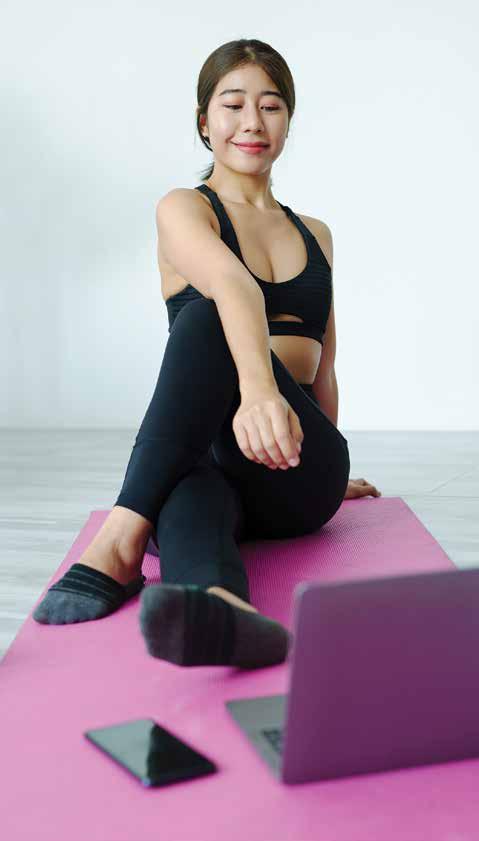
It’s Sunday – you’ve just come home from the gym, a busy workweek is looming and you’re staring at a blank grocery list. Should you opt for takeout, or should you ask ChatGPT to throw together a grocery list?
You’re a first-time marathon runner. You’re unsure if you should run two or 10 miles tomorrow, you’ve read all of the advice articles on Runner’s World, and you’re looking for more advice. Should you turn to AI?
As the world of artificial intelligence rapidly expands, AI has become a popular resource for health advice. While AI is a free resource with an endless stream of information, it is important to not confuse its split-second answers with those of a certified nutritionist. AI can be a valuable tool in achieving your fitness goals; however, it is crucial to know the best ways to utilize it.
Prioritizing fitness isn’t easy, and knowing how is even harder. Since ChatGPT’s launch in 2022, users have turned to AI for personalized training programs and meal plans focused on meeting goals and maintaining motivation.
The days of searching the internet for generic 20-minute ab workouts are over. AI can now help create a personalized training plan tailored to your fitness goals, current ability, body type and other key factors.
There is a range of apps to choose from, such as Fitbod, Freeletics and Nike Training Club, which use machine learning algorithms to formulate personalized routines that evolve as your performance improves.
A huge advantage of these apps is their ability to process data in real time and adjust plans accordingly. To do this, apps connect with smart devices such as watches and heart rate monitors to track fitness metrics, including calories burned, heart rate, step count, sleep patterns and
Fitbod: This AI-driven app is a great option for anyone looking to increase their general fitness. The app creates strength-training workouts personalized to your fitness goals, taking into account equipment availability and recovery tendencies when crafting plans.

Suited for: those looking to improve overall fitness and lifters with access to weights
Limitations: requires a subscription for long-term use
Nike Training Club: Users are granted free access to a range of workouts through Nike, from yoga to high-intensity interval training (HIIT). Workouts are on-demand and catered to your goals and fitness level.
Suited for: those seeking guided instruction without equipment
Limitations: lack of personalized recommendations or feedback
Freeletics: For those who prefer to skip the weights, Freeletics offers a library full of bodyweight workouts that can all be done at home.
Suited for: home workout enthusiasts and beginners
Limitations: most personalized features require payment
Runna: For those looking to try their first 5K or improve their running endurance, this app offers personalized running training plans. It also acts as a virtual running coach, providing workouts that take into account your goals, experience and schedule.

Suited for: runners training for races or building endurance
Limitations: requires subscription after trial for full access, limited cross-training guidance
Although AI offers dynamic ways to meet your fitness goals, it should not be viewed as a replacement for certified fitness coaches and nutrition professionals. There are several factors to consider if you are opting for a digital coach.
Accuracy: Many AI tools boast personalized plans, but ultimately, recommendations are still based on data
patterns. Data can be inaccurate, which can lead to inaccurate recommendations.
Emotional negligence: As real as chatbots may feel, they cannot understand human emotion. A personal trainer can sense mental barriers and adjust training plans accordingly.
Safety: Even the most advanced AI trainers cannot correct your form in real time or recognize when a workout might be unsafe. Poor technique or pushing too hard can lead to overuse injuries, joint strain and muscle imbalances, issues a real trainer is better equipped to help prevent.
Data privacy: Allowing AI-based fitness apps to create tailored plans means sharing sensitive health and personal data. There are risks of how your information is stored and used and a potential for inaccurate health recommendations.

general workout intensity. If your sleep routine is off or you over-exerted yourself during a workout, this data will be collected and used to adjust your next few workouts accordingly.
AI also works to enhance motivation and maintain engagement through gamified features, reminders and progress tracking tools. Some apps offer virtual coaches to answer questions, offer feedback and provide positive reinforcement throughout your plan.
AI can be a valuable tool in achieving your fitness goals; however, it is crucial to know the best ways to utilize it.
Fitness is much more than lifting weights and burning calories. Without proper nutrition, even the most intense workout regimen will fail. Meal planning and prepping are beneficial to prioritizing nutrition, and AI can aid with this process.
Apps such as MyFitnessPal and Lumen use AI to analyze dietary habits, exercise and metabolic rate to formulate personalized meal plans and recipes. This negates the need to search for recipes and calculate nutritional content.
While you build your grocery list, AI can also give insight into new recipes you may not have tried before, making healthy eating exciting and fresh. In addition to variety, you can tailor your grocery lists to stick within certain budgets to help limit food waste.
MyFitnessPal: This app tracks calories, macros and micronutrients through an extensive food database to guide eating habits. Users simply input their daily intake, and they will be given suggestions of how to maintain or improve their nutrition in order to meet their goals.
Suited for: those who want to understand their eating habits and follow a macro-based approach
Limitations: Free version includes ads, AI insights are limited without a premium
Lumen: Lumen pairs with a handheld device to measure your metabolism and provides personalized nutrition and exercise guidance based on your body’s fuel usage.
Suited for: users focusing on metabolism and fat loss
Limitations: a device is required, and may not be suitable for all diets


Just as with fitness, seeking nutritional advice through AI comes with a warning sign. AI is not a certified nutritionist, so it is important to review its recommendations as you curate your nutrition plan.
Simplicity: Nutrition science is complex, and AI creates recommendations based on general research data, rather than considering behavioral, psychological and environmental aspects.
Accuracy: AI sometimes relies on outdated food databases or misreads user input, which may result in inaccurate calorie or nutrient recommendations.
Promoting disordered eating: Consistent tracking of food and calorie intake can promote an unhealthy relationship with food, leading to harmful disordered eating habits.
Culture and lifestyle awareness: AI often does not factor in socioeconomic access to food, diverse eating habits or cultural traditions, sometimes leading to generic or unrealistic meal plans.
Dietary restrictions: Most apps aren’t designed to account for food allergies, intolerances, chronic health conditions such as diabetes or individual metabolic differences.
Many of these apps use tools such as barcode scanning, photo recognition and extensive food databases to make tracking meals quick and efficient, helping users monitor their progress more easily. Some even include hydration reminders and sleep recommendations to coincide with meal plans.
AI is a powerful tool for those seeking convenient and accessible support for health goals. From custom workouts to grocery lists, AI-based apps and sites can simplify steps and motivate users to stick to their goals. As technology continues to evolve, we can expect even more seamless integration between AI tools and expertled guidance.
However, no matter how advanced AI becomes in the future, it will never replace the expert guidance of trained professionals. Certified trainers and dietitians offer personalized guidance that AI can’t match, factoring in things such as form, burnout, mental health and medical history.
The key is learning how to implement both resources. By combining the efficiency of AI with the expertise of trained professionals, you can craft a plan that is both realistic and personalized.
Megan Brokamp is an editor at CityScene Media Group. Feedback welcome at mbrokamp@cityscenemediagroup.com.
How long have you lived in New Albany?
Our family moved to New Albany in 1993 from Dublin, drawn by the promise of future growth and a shared commitment to building an exceptional community. At that time, much of what residents cherish today—the school campus, Village Center, parks, fire station, and the McCoy Center—had yet to be built. Over the past 32 years, it has been incredible to watch New Albany evolve into one of the finest communities in America.
What is your favorite New Albany spot?
My favorite spot is the heart of town, where the library, restaurants, and coffee shops create a vibrant gathering place. It’s the perfect spot to meet friends, enjoy the Farmers Market, savor the Taste of New Albany, and even catch the July 4th fireworks. This area truly embodies the charm of small-town America and serves as the welcoming centerpiece of our community.
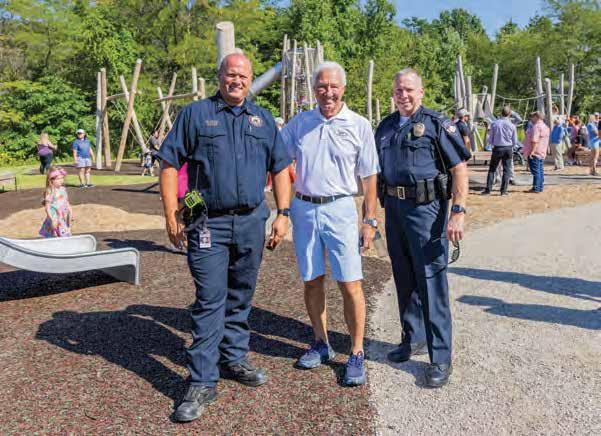

What is the one thing people don’t know about you?
Growing up and throughout my career, we lived in Cleveland, Toledo, and Dublin before settling in New Albany. In 1999, I was offered a significant corporate opportunity in Detroit. However, New Albany had become home, and my wife Lorrie and I were committed to raising our children here. To make that possible, I commuted to Detroit every Monday and returned home on Thursdays for 11 years (approx. 252,000 miles). It wasn’t the easiest arrangement, but ensuring that Lorrie and our kids could live and experience this extraordinary community was far more important—and absolutely worth it.
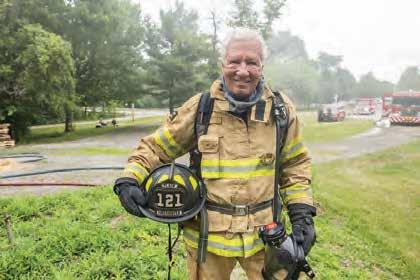
Why did you initially get involved with serving on City Council?
During my corporate career, I was incredibly busy and traveled often, which limited my ability to engage with the community. When I retired, I saw it as the perfect opportunity to give back and contribute to New Albany’s future growth and direction. I was first invited to join the
To learn more, visit: newalbanyohio.org/city-council-mayor






in my current term.
What are you most proud of during your time in office?
I am most proud of New Albany’s remarkable economic growth and its emergence as a premier destination for major technology companies and data centers. This level of development has brought significant investment, job opportunities, and long-term financial stability to our community. Equally important is our commitment to maintaining the high quality of life that makes New Albany so special. Through strong financial planning and responsible fiscal management, we have been able to expand our parks and trails, enhancing recreational opportunities for residents of all ages. Seeing our city grow while preserving its unique character and sense of community has been incredibly rewarding, and I am honored to have played a role in shaping its future.
What is an initiative you see the City working on that residents can watch for in the coming months?
One major initiative currently underway is the extension of Market Street east beyond SR-605. Once completed, this project will help alleviate traffic congestion in the Village Center and provide an additional option to access US-62 and the SR-161 interchange, improving overall connectivity. Additionally, the next phase of Rose Run Park is in the planning stages. This expansion will further enhance the park’s natural beauty and recreational opportunities.

By Katie Allen, City of New Albany Communications &

When we moved back to central Ohio, we knew exactly what we wanted – but only found it in New Albany. The deciding factor was the leisure trails. No other community offered the same blend of green space, peaceful atmosphere and safe, connected walkways just 15 miles outside of downtown Columbus.
In New Albany, wellness and connectivity are built into the landscape. With more than 83 miles of leisure trails, thoughtfully designed parks and scenic pathways, it’s no surprise that walking, jogging and cycling have become second nature to residents. These trails are more than just recreation routes – they reflect decades of planning and investment in community well-being.
New Albany’s first strategic plan, adopted in 1998, laid the groundwork for a community connected by sidewalks, trails
and green space. That vision continues to grow today.
“Our commitment to expanding New Albany’s leisure trail system is backed by multiple strategic plans, Engage New Albany, Bike New Albany and the Parks Framework Plan, all formally adopted by City Council. These plans guide how we build and connect trails to ensure that, ultimately, when it’s all said and done, 86 percent of residents will live within a 10-minute walk of a park,” says Stephen Mayer, New Albany deputy director of public service.
New Albany’s 83+ miles of leisure trails wind through neighborhoods, parks, business districts and natural areas, con-
necting people to key destinations. From Market Street and the school campus, to metro parks and nature preserves, these trails make it easy to choose your feet over four wheels. The City of New Albany adds roughly two to three miles of trails each year – an impressive pace for a community of its size.
Among the crown jewels of the trail system are Rose Run Park and Taylor Farm Park – two spaces that beautifully blend nature with thoughtful design.
“We absolutely love the walking paths and the wildlife,” says Morgan Cooper, mom of two and New Albany resident. “On one walk, we spotted a baby beaver playing in the water!”

Once a working farm from the 1800s, Taylor Farm Park now spans nearly 100 acres with 2.9 miles of trails, wood boardwalks and eco-friendly paths through wetlands. With a playground, community garden and restrooms, it has quickly become a beloved spot for all.
“My daughter, Olive, is disabled, and having an accessible trail and playground nearby has been life-changing for us,” says Natalie Goss, a New Albany resident. “We live behind Taylor Farm Park and walk there now year-round. It allows us to be outside, connect with others and regulate.”
Rose Run Park, located between Market Square and the learning campus, serves as the city’s civic green. Its 1.7 miles of trails connect the community to cultural, educational and retail hubs while preserving green space in the heart of town. Rose Run Phase II – slated for future development – will add a Veterans Memorial, Hero’s Walk and water feature.
New Albany’s trails connect 10 major parks and six neighborhood pocket parks, making it easy to find a family-friendly route close to home. Whether exploring Swickard Woods Nature Preserve or wandering through Ratchford Fens Park, there’s something for everyone.
“Over the years, the City has created a number of great parks and leisure trail connections for all the community to enjoy. It’s one of the best ways to ensure we’re living up to our motto of Community Connects Us,” says Councilmember Chip Fellows, liaison to the Parks & Trails Advisory Board.



Scan the QR code to view the full Leisure Trail Master Plan. Or visit: newalbanyohio.org/ wp-content/uploads/2016/04/ 19-0617-LeisureTrail-Master-PlanFinal.pdf

New Albany’s trail system is possible in large part due to its income tax strategy. Roughly 80 percent of the City’s general fund comes from income taxes – primarily from the New Albany International Business Park. That funding supports essential services such as police protection, snow removal and the leisure trail development and upkeep.
“I can honestly say that our system of trails is not only the most scenic in central Ohio, but also thoughtfully designed so it’s easy to return to your starting point –no matter where you begin,” says Dr. Phil Heit, Founder of Healthy New Albany. “The ability to take in such a variety of beauty along the way is what makes New Albany’s trails truly unique.”
Sustainability is part of the plan. Some newer trails in our parks use permeable surfaces to reduce runoff and recharge groundwater. New “Pocket Prairies” coming soon will bring native grasses and wildflowers – supporting pollinators, reducing mowing and enhancing natural beauty.
Plans for future expansion include new trails and pedestrian improvements along Bevelhymer Road and Walnut Street, eventually connecting more than 800 homes in neighborhoods such as The Links, Millbrook and Upper Clarenton to the new Community Fieldhouse.
“Trails don’t happen by chance in New Albany, they’re part of a long-term vision,” says Chris Christian, Planning Manager.
And that vision continues to unfold, one thoughtful connection at a time.




It’s 1971 and I am focused on being competitive in both finish time and place for the NYC Marathon, held in Central Park. At that time, and for a number of years after, the course consisted of four loops, each six miles long, plus a 2.2mile loop for a total of 26.2 miles. Sounds simple enough. Just do your warmup; wait until Fred Lebow, the race director at that time, gets on his bullhorn to summon the few hundred runners to approach the starting line; and begin to run at the sound of the starter’s pistol.
And for many of my competitive races, the routine would be constant. Register for the event, focus on my training regimen and approach race day with the same verve as always. On race day, I’d approach the starting line and manage to squeeze past the queue of runners standing shoulder-to-shoulder as I work my way toward the front. And off I go.
In 1978, I had an epiphany. I am going to create and conduct a large-scale race. Thus, the Olentangy Run became a reality and, in its first year, became one of the premier races in central Ohio, attracting thousands of runners.
At that time, I did not realize nor have an appreciation of the complexities involved in conducting a race, whether for runners or walkers. ‘Don’t you just
show up, do the race, enjoy the post-race activities and go home?’ I thought.
I venture to say that such is the thinking of almost every walker who participates in the New Albany Walking Classic®, hereinafter referred to as the Walk. Just show up, partake in the Walk and all it has to offer without giving thought to the hundreds of details and length of time invested in the planning and execution of the event.
It takes a community. The City of New Albany works closely with Walk personnel to make sure that city services and law enforcement are unified and coordinated in protecting all participants. Hundreds of volunteers, a good number of whom are students in the New AlbanyPlain Local Schools, gather to perform various tasks on race day well before the sun rises. Equipment must be ordered, giveaways for participants such as medals and garments are to be determined and

purchased months in advance, paying close attention to expenditures. The expenses incurred in order to conduct the Walk are significant. Enough cannot be said about the corporate and individual sponsors whose generosity supports this first-class event. Participant registration fees play a significant role as these fees are donated to Healthy New Albany, a nonprofit organization that provides health programs and services to the community in support of entities such as the farmers market, food pantry, community garden, education programs to people across all ages and so much more.
When you step up to the starting line on Sept. 7, think about the effort undertaken for the Walk to take place. Additionally, thank a volunteer. Support a corporate sponsor. Say hello to the police officer monitoring an intersection on the course. Show your appreciation to Healthy New Albany by participating in its many program offerings. Visit www. healthynewalbany.org and support this community gem with a donation. Have an awesome Walk experience.
Healthfully, Phil Heit Founder, New Albany Walking Classic®
Which is Better? How your walking environment impacts your mind and body
By Elise Conrad
Walking is one of the most accessible forms of exercise, but where you choose to walk can shape the experience. From treadmills to tree-lined trails, each option offers its benefits and drawbacks.
Walking in nature offers a range of physical and mental health benefits beyond what a treadmill can provide. A 2016 review published by the International Journal of Environmental Research and Health found a significant decrease in cortisol levels when participants were exposed to natural environments. Cortisol is a hormone that is released as a result of stress, and consistently high levels can take a toll on both physical and mental health. In other words, choosing a nature walk doesn’t just benefit your body; it can also help calm your mind.
The environment you choose to walk in also plays an important role. In a 2015 study published in Landscape and Urban Planning, 60 participants were randomly assigned to a nature walk or a walk in an urban neighborhood. Those who went on the nature walk reported a more significant decrease in anxiety and rumination, as well as an increase in working memory,


compared to those who walked in the urban environment.
With more than 230 miles of trails and more than 150 parks, choosing where to walk in central Ohio can feel overwhelming, so we’ve made it easier by matching trail suggestions to what you’re looking for.
If you’re seeking…
Reflection: Go on a meditative walk at Blendon Woods, with more than four miles of walking trails.
Routine: Meander on down to German Village for a mindless stroll through this urban neighborhood.
Energy: Walk through the Short North and absorb the lively atmosphere, stopping by local stores and restaurants on North High Street.
Stress relief: Take a stroll through the Hayden Falls Nature Preserve, enjoying the vibrant greenery and a 30-foot waterfall.
Because walking outdoors entails walking on different terrains, it can be more challenging than walking on a flat surface indoors, even if that surface is an inclined treadmill. This strengthens different muscles – such as the core, quads and glutes – increasing stability and overall strength.
Here’s another tip: Try walking without headphones or staring at your phone. Studies show that mindfulness, or mindful walking, further lowers cortisol production in the body and improves attention and concentration. It also boosts

self-awareness and emotional regulation, helping you feel more grounded and in tune with your surroundings. By walking without distractions, you allow your mind to rest and reset, turning an everyday walk into a moment of calmness and clarity.
If you’re prone to injury or recovering from one, it may be a better idea to walk inside. Walking outside can come with stray rocks, curb drops and loose gravel. While outdoor and treadmill walking both come with injury risks, doctors suggest that outdoor walking has a slightly higher risk of injury due to environmental factors and terrain.
Additionally, when you’re indoors, the weather doesn’t matter. Unless a storm knocks out the power while you’re on the treadmill, rain or shine, you can hop on a treadmill to get a few miles in.
Though walking indoors is more predictable and safer, it still doesn’t have the same mood-boosting benefits that walking in nature does.
Additionally, being outside under the sun significantly boosts vitamin D production, which further regulates mood and supports the immune system.
And the verdict is…
So, which is better? There is no right or wrong answer. Ultimately, the best op-
tion is the one you’ll stick with. But considering how nature can uplift your mood in ways indoor walking can’t, outdoor walking may offer more unique advantages.
Feedback welcome at
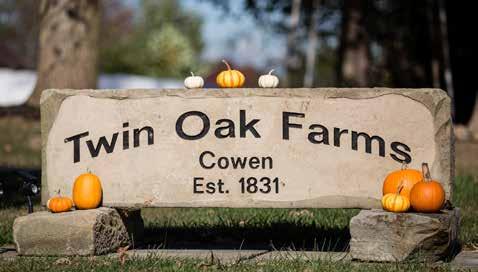

By Maxwell Knauer
Tired of getting passed by your culde-sac rivals on your morning stroll?
Then you’ve come to the right place. This guide will help you become a faster, more motivated walker.
From step trackers to smart shoes, today’s gadgets go beyond counting steps. They offer insight into your body’s patterns, provide motivation and even help improve posture and mobility.
You don’t need fancy gear to start walking with purpose, just clear goals. Smartphones already come equipped with pedometers available through programs such as Apple Health and Google Fit, which track your steps in the background. Open the app, check your trends, set a daily goal and you’re off.
Walking isn’t just about burning calories or reaching a daily step goal. For many, it’s a way to recover, improve balance or relieve stress. Tech can support those goals, too.
Apps such as Pacer go beyond simple background tracking, offering nudges, guided walking plans and encouragement
A 2022 Lancet study found that people who monitor their physical activity take, on average, 1,800 more steps per day. Visual feedback such as seeing your step count climb or hitting a daily streak really does boost motivation.
And if you need a little community motivation, try an app such as Strava, where you can log walks, share photos and even get a bit competitive with friends (or friendly neighborhood rivals)

throughout the day. It’s free and beginnerfriendly, but its customizable programming allows it to grow with you.
On the more advanced end, wearable tech is now being used in rehabilitation and mobility support, especially for individuals recovering from injury or managing chronic conditions.
The ReLOAD system (Rehabilitation Lower Limb Orthopedic Assistive Device) is one such tool. Designed for veterans and others with mobility challenges, ReLOAD uses body-worn sensors to track stride, balance and joint movement in real time. The data is sent to a mobile device, offering instant feedback and customized exercises.

Another is the Cionic Neural Sleeve, named one of TIME’s Best Inventions in 2023. This FDA-approved sleeve uses artificial intelligence and electrical stimulation to help individuals with foot drop or multiple sclerosis walk more naturally. Worn around the upper and lower leg, it detects the wearer’s gait in real time and activates muscles to improve stride and control.
If you’re ready to invest in something more advanced and elegant, there are smartwatches and shoes that combine performance with polish.
The Apple Watch Ultra 2 is built for the outdoors and also works well in your daily routine. It tracks everything from walking and running to ECG data and fall detection. The Garmin Venu 3 offers excellent sleep tracking, respiration data and wellness insights with a more understated look.
For footwear, try the NURVV Run Smart Insoles, pressure-sensitive inserts that slide into your existing shoes and track foot strike pattern, balance and ca-

dence. They pair with a smartphone app and give real-time coaching to help improve posture and walking efficiency.
Maxwell Knauer is an editorial assistant at CityScene Media Group. Feedback welcome at feedback@cityscenemediagroup.com.



By Elise Conrad
Have you ever been walking or running and felt a little unsteady? Core exercises can help with that. A 2021 review published by Crimson Publishers found that core strength training improves functional mobility and balance in those 65 and older. According to Mayo Clinic, having strong core muscles impacts nearly every facet of our lives. These muscles make it easier to do everyday activities, leading to fewer injuries, and preventing poor posture and lower back pain, which affects approximately 80 percent of Americans.
Stability starts with your core, the group of muscles in your midsection that provides support and control for your spine and pelvis. When these muscles are weak, it can result in pain and movement issues throughout the body.
The core also impacts stride length, which is important for any avid walker or fitness fan. Optimizing stride length can improve walking efficiency, reduce fatigue and potentially lower the risk of certain injuries.
Improving core strength also stabilizes the body, resulting in a smoother, more powerful stride. A strong core allows the pelvis, hips and lower back to work together, leading to less energy expenditure and a lower chance of getting hurt from poor form.
Core strength reduces the overall risk of falls by helping the nervous system maintain balance and better coordinate movement. In a 2013 mega-analysis published in Sports Medicine, researchers concluded that core strength training can increase strength by 30 percent and balance by 23 percent.
Because various core exercises engage different muscle groups, it’s essential

to strengthen all of them to get the most out of your core training. To reap the full benefits, the core only needs to be trained two to three times a week for 15 minutes at a time.
To build a well-rounded core, aim to include a mix of exercises that target the front, sides (obliques) and back. Here are a few effective, beginner-friendly core exercises to get started:
Plank: Hold a strong, straight position on your forearms and toes to engage your entire core. Start with 20-30 seconds and build up.
Bird-Dog: From a hands-and-knees position, extend opposite arm and leg, then switch. This boosts balance and coordination.
Leg Lifts: Lie on your back with your arms by your side. Slowly raise and lower your legs, keeping your core engaged.
Glute Bridge: Lie on your back, knees bent, feet flat. Lift your hips to strengthen your glutes and lower back.
Side Plank: Support yourself on one forearm and the side of one foot to work your obliques. Hold for 15-30 seconds per side.
Elise Conrad is an editorial assistant at CityScene Media Group. Feedback welcome at feedback@ cityscenemediagroup.com.


Robin Roberts Co-Anchor of ABC’s ‘Good Morning America’, Best Selling Author & President, Rock’n Robin Productions

Interviewed by Doug Ulman Pelotonia Vice Chair & Founder, Orli

James Carville Political Icon

Reince Priebus White House Chief of Staff (2017) & Republican National Committee Chair (2011-2017)
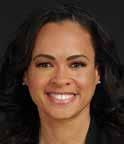
Moderated by Linsey Davis Host and Radio Correspondent, ‘World News Tonight Sunday’ and ‘ABC News Live Prime’

Lt. Gen. H.R. McMaster National Security Advisor, Lieutenant General, U.S. Army, Retired and Bestselling Author

Sec. Mike Pompeo 70th Secretary of State (2018-2021), Former Director of the CIA (2017-2018)

Moderated by Jim Sciutto CNN Anchor and Chief National Security Analyst

Christian Slater Award Winning Actor & Mental Health Advocate

Interviewed by Neda Ulaby Reporter, NPR’s Arts Desk

By Avery Gillis
Tired of the same walking playlist and looking for a new way to make the miles fly by? Try interval training, a dynamic workout that will increase your endurance and speed.
Interval training alternates periods of brisk walking followed by a slower recovery period. For those lacing up their sneakers for their first interval walk, each period of higher-intensity walking should only be about one minute for every five minutes walked at a moderate pace. As the walker’s stamina improves, their periods of rest get shorter.
The workout is designed to allow walkers to get more bang for their buck, completing a less time-consuming workout while still enjoying the fitness benefits of a longer, more moderately-paced workout.
According to Canadian Science Publishing, by getting their hearts pumping, walkers can expect improved physical fitness, with reductions in blood pressure and BMI lowering the overall risk of lifestyle-related disease.
Hopping on the treadmill for an incline workout combines muscle building with the health benefits of high-intensity walking. In addition to being another low-impact way to work out, incline training targets the quads and glutes to build strength and improve flexibility in the legs, according to the faith-based, non-profit health system Texas Health Resources
Building muscular strength isn’t only important for bodybuilders and gym rats. As stated by News in Health, it offers a whole host of health benefits, from preventing diabetes to maintaining bone health
In fact, according to Runner’s World, walking on an incline has similar benefits to running. The inclined terrain provides resistance that pushes the heart and lungs to work harder.

For those who enjoy their daily walks outdoors, let certain landmarks on your route dictate your intervals. Pick up the pace until you pass a dog walker or slow it down for the length of three houses. Take in your surroundings while getting fit.
Can’t find an outdoor route? Using the treadmill for incline workouts allows walkers to introduce interval training to their walk in a different way by controlling the level and duration of their incline. There are different ways to approach an incline interval workout, such as Runner’s World’s Pyramid Scheme workout. This exercise involves increasing the speed and intensity of the incline for four intervals, then decreasing for four intervals. The Pyramid Scheme focuses on increasing intensity gradually, providing a starting point that can be adjusted as walkers gain experience with incline training.
Avery Gillis is an editorial assistant at CityScene Media Group. Feedback welcome at feedback@cityscenemediagroup.com.


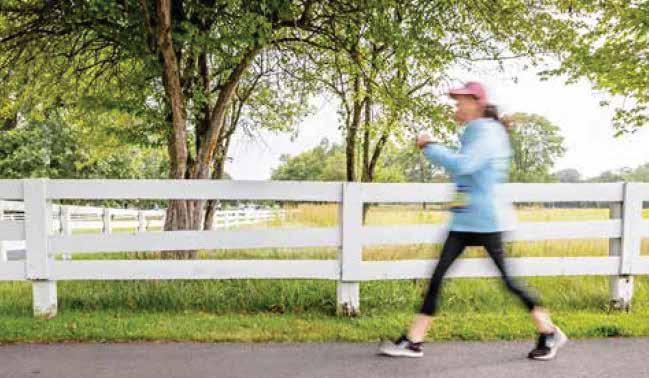



By Megan Brokamp

You’ve built the training plan and perfected your post-race stretch routine, but have you planned your post-race recovery? Although proper training is important, your nutrition can be just as crucial to a successful recovery.
Effective post-race fueling is key to repairing muscles, reducing soreness and restoring energy, helping your body maintain strength and remaining in peak condition. Throughout a race, your body relies heavily on glycogen, its stored form of carbohydrates, for energy.
In especially intense or sweaty efforts, you also lose electrolytes, such as sodium
Not a fan of Gatorade or Liquid I.V.? Tart cherry juice is rich in antioxidants and anti-inflammatory compounds that can help reduce muscle soreness and speed up recovery after a race.
and potassium. Replenishing these depleted nutrients promptly is essential to avoid prolonged fatigue, soreness or a sluggish recovery. Whether you’re running a marathon or walking a 5K, there are several tips to help master the plate after the race.
The key to great performance and recovery is to plan out your nutrition before, during and after races. Before a race, it is best to eat a balanced meal of mostly simple carbohydrates and a small amount of protein. Whether you need to pack fuel during a walk or run depends on the length and intensity. For races under an hour, hydration will suffice. For efforts lasting 75 minutes or longer, especially those of a higher intensity, try easily digestible carbohydrates such as fruit or energy gels.
Once you cross the finish line, aim to refuel within 30-60 minutes post-
race. According to Runner’s World , this period is considered the recovery window and it is when your body can best absorb nutrients and kick-start the recovery process.
Although the hours after a race are a time to celebrate, make sure to prioritize a healthy meal first. There’s plenty of time for drinks and desserts, but it is best to opt for a meal of carbs and protein during your recovery window. Carbohydrates restore energy by replacing glycogen stores, while protein helps rebuild muscles.
No time to cook up a meal? There are plenty of quick snacks to save time while satisfying your post-race cravings.
• Chocolate milk
• Greek yogurt with fruit
• Premade protein shake and smoothie
• Bagel with nut butter
• Oatmeal
Before you indulge in a post-race brew, prioritize rehydration. Alcohol can exasperate dehydration and prohibit effective muscle recovery. According to the University of Utah, after a race, athletes should drink approximately 32 ounces of water per hour raced. This ratio combats post-race fatigue and is especially important if you experience dehydration during the race.
On hot days or after particularly intense efforts, water might not be enough. Opt for electrolyte-boosting drinks such as sports drinks, coconut water or electrolyte tablets.
Your recovery shouldn’t stop after the first meal. For the next one to two days, focus on nourishing meals packed with whole foods. Swap simple carbs for complex ones, and opt for lean proteins and healthy fats. Anti-inflammatory foods such as berries, leafy greens, nuts and fat-
A banana stockpile has grown to be a tradition at the end of races, and for good reason. Bananas are fast-digesting carbs that quickly replenish glycogen stores after a race. They’re also packed with potassium, an electrolyte that aids in muscle function and helps prevent post-race cramping. Plus, bananas contain tryptophan, an amino acid that aids in serotonin production, so your post-race snack can even lift your mood.
ty fish can help reduce inflammation and aid in muscle repair.
Examples of balanced meals for recovery include:
• Grilled salmon with quinoa and roasted vegetables
• Vegetable rich omelet with fruit
• Smoothie bowl with protein powder, fruit and nuts
• Beef stir-fry with broccoli, bell peppers and jasmine rice
• Baked sweet potato with black beans, salsa and avocado
Megan Brokamp is an editor at CityScene Media Group. Feedback welcome at mbrokamp@cityscenemediagroup.com.
Smoothie
In a blender, add:
• 1 frozen banana
• 1/2 cup orange juice
• 1 tbsp. apple cider vinegar
• 1 cup ice
• 1/2 cup vanilla Greek yogurt
• 1/2 tsp. grated ginger
Optional: 1 scoop of protein powder or collagen peptides of choice


• Pain in calf or thigh muscles when walking
• Tingling, heaviness, numbness or swelling of your lower extremities
• Restless legs at night when trying to sleep
• Varicose veins (especially for women who develop varicose veins after pregnancy)
• Sores and ulcers of the feet and ankle that don’t heal
• Foot and ankle ulcers
If you have any of these issues, find out if you’re at risk—for free.



Ingredients:
• 1 cup unsweetened dried blueberries
• 3/4 cup old-fashioned rolled oats
• 3/4 cup smooth natural almond butter or sunflower seed butter
• 1/2 cup chopped dried figs
• 1/2 cup chopped pecans toasted
• 3 tbsp. chia seeds
• 2 tbsp. honey
• 1 1/2 tsp. vanilla extract
• 3/4 tsp. ground cinnamon
• 1/8 tsp. salt
Topping:
• 2 tbsp. unsweetened dried blueberries
• 1/4 cup white chocolate chips
Directions:

Toast pecans in a small dry skillet on medium heat for about 2-4 minutes or until pecans are fragrant. In a food processor, combine 1 cup blueberries, oats, choice of almond or sun butter, figs, pecans, chia seeds, honey, vanilla, cinnamon and salt until mixture is firm and crumbly.
With wet hands, roll the mixture into 1 tbsp. balls. Place balls on a baking sheet lined with parchment paper.
To make garnish:
Chop the remaining 2 tbsp. of blueberries.
Using a microwave safe bowl, heat white chocolate chips in 30 second increments, stirring in between. Repeat the process until the chips are melted and smooth.
Drizzle energy balls with melted white chocolate and top with chopped blueberries.
Turmeric Smoked Salmon Bowl
Ingredients:
• 1 large sweet potato, peeled and cubed
• 2 tsp. olive oil, divided
• 3 tsp. turmeric, divided
• 1 cup uncooked quinoa
• 2 eggs (alt: 2 sliced hard-boiled eggs)
• 2 cups mixed greens or spinach, torn
• 8 oz. smoked salmon
• 2 radishes, thinly sliced
• 1/2 avocado, peel and pit removed, sliced lengthwise
• 1 tbsp. hemp seeds
• 8 oz. plain Greek yogurt
• 1 tsp. cayenne pepper or harissa
• Juice of half a lemon
• Salt and pepper
Directions:
Drizzle 1 tsp. of olive oil on a tray, peel and cube sweet potato, place on a baking sheet and drizzle another tsp. of olive oil over the potatoes before covering with 2 tsp. turmeric, salt and pepper.
Place the tray in an oven at 400 F for 7 1/2 min., then flip and cook for another 7 1/2 min.
Boil 1 1/2 cups of water, add quinoa and simmer for 12-15 min.
Cook eggs as desired and set aside.
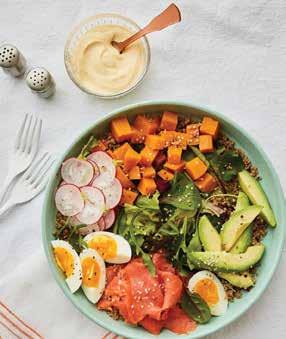
Mix yogurt, 1 tsp. turmeric, cayenne pepper, lemon juice, salt and pepper to make sauce. To assemble, place quinoa, greens, sweet potatoes, smoked salmon, avocado, sliced eggs, radishes and hemp seeds in a bowl and top with sauce. If prepping bowls for later, separate quinoa, sweet potatoes and sauce to refrigerate. Make eggs when ready to assemble and reheat quinoa and sweet potatoes.

By Jane Dimel
As The New Albany Lecture Series enters its 13th season, new speakers bring unique insights to community-selected topics including health and wellbeing, civil discourse and debate, national security and mental health.
Each topic stems from community interest, from educators talking about navigating conversations involving mental health between students and families, to the foundation looking to connect with veterans and active military personnel on national security and foreign affairs. But, how did the Lecture Series itself start?
The initial idea for the Lecture Series, as long-time president of the New Albany Community Foundation Craig Mohre recalls, can be traced back to his start as president and the 2002 A Remarkable Evening event with two-time Pulitzer Prize and National Book Award winner David McCullough.
Oct. 9
Good Morning America host and cancer survivor Robin Roberts will be interviewed by Pelotonia’s Vice Chair and fellow cancer survivor Doug Ulman. From their joint experiences – Roberts with the bone marrow disorder myelodysplastic syndromes (MDS) and breast cancer, and Ulman with bone cancer (chondrosarcoma) and malignant melanoma twice –this matchup will be one to listen to for discussions of health journeys and recoveries.

The event not only went on to raise more than one million dollars towards opening the New Albany Branch of the Columbus Metropolitan Library, it also highlighted the community’s excitement and engagement with the topics McCullough had brought forward, especially students.
“It occurred to me that the real core to lifelong learning is curiosity… and that if we could bring leaders to the community routinely, they could meet with the students and their parents and their grandparents, and it could be a multigenerational endeavor and really bring the community together,” Mohre says.
The community reception of this event inspired the joint community Lecture Series and Student Lecture Series.
Both series reach more than just the local community. The New Albany Student Lecture Series alone has welcomed more than 35,000 students from roughly 50 local high schools to watch student moderators talk with speakers.
With the draw of local and national experts across a variety of fields and professions, The New Albany Lecture Series is set to bring meaningful discussions around community topics this season.
This season welcomes several new guests as well as a few familiar faces.
Returning for his third time as an interviewer, Vice Chair of Pelotonia Doug Ulman opens the series with Good Morning America host and fellow cancer survivor Robin Roberts – as they discuss health and wellbeing.
Both Ulman and Roberts are vocal about their journeys with cancer and advocate for providing more support to can-
In conjunction with Robin Roberts’s participation in the Lecture Series, The New Albany Community Foundation has brought together a partnership between Healthy New Albany, OSUCCC – James and Pelotonia to create programming to raise awareness around cancer prevention. detection and care.
To learn more about this programming, read more on page 40.

“I think it’s so critical for people to be willing to share their experience, because it can do a number of things. It can inspire others to get screened, ... It also just gives human connection. So many people have been through something, whether it’s a health scare or experience or a family member diagnosis, so it’s relatable and relevant. I think we call all takeaway a lot from hearing somebody else’s journey.”
— Doug Ulman, Vice Chair of Pelotonia
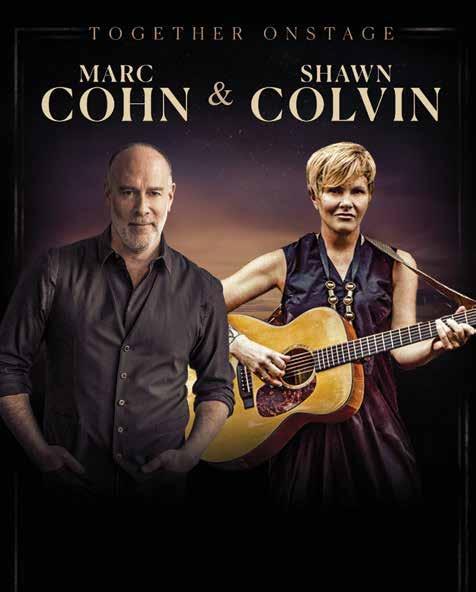
SATURDAY
OCTOBER 18
Don’t miss an unforgettable evening with platinum-selling singer-songwriter Marc Cohn and GRAMMY®-winning musician Shawn Colvin— two celebrated artists sharing songs, stories, and the stage in a rare, intimate performance.



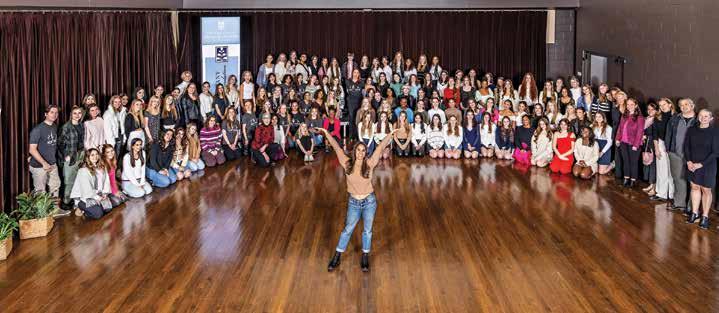
cer patients, which will be a core topic of their discussion.
“She has a very great, open way of authentically sharing what she went through, the highs and lows, but also with this unbelievable attitude and approach, so I think that will be both authentic for the audience but also inspiring,” Ulman says.
“I never think the goal is to sugarcoat or gloss over the human sort of aspects of a diagnosis and treatment and recovery and survivorship, so my hope is that we’ll be able to dive into the emotion of what that journey was like for her because every journey’s different,” he adds.
Jan. 28, Civil Discourse & Debate: Former White House Chief of Staff and Republican National Committee Chair Reince Preibus will discuss civil discourse and debate with Democratic political consultant and campaign strategist James Carville.
From high school campaign volunteer to national chairman of the Republic National Committee (2011-2017) and the 27th chief of staff in the early months of the 2017 administration of Donald Trump, Preibus is now the president, chief strategist and board chairman of law firm Michael Best. He is also a naval officer as a lieutenant for the Bureau of Naval Personnel.
Carville has worked as a Democratic political consultant and campaign strategist across states, nations and public offices, working on gubernatorial, senatorial, presidential campaigns and more, including Bill Clinton’s 1992 presidential campaign as lead strategist and consultant. Carvis was previously enlisted as a Marine Corps corporal as well. Now, he works as an attorney, and publishes political work, from nonfiction novels to podcast Politics War Room with James Carville & Al Hunt
The conversation will be moderated by host and correspondent for World News Tonight Sunday, ABC News Live Prime and more, coverage anchor for presidential debate and election, and Lecture Series regular Linsey Davis.
Mar. 3, National Security: Retired U.S. Army lieutenant general and National Security Advisor H.R. McMaster will speak on national security with Mike Pompeo, former Secretary of State, director of the CIA and retired politician.
As a three-star lieutenant general and doctor with a Ph.D. in American history, McMaster has extensive knowledge on military history, leadership and strategy. Involved in several conflicts including the Gulf War, Operation Iraqi Freedom and more, McMaster was also an active-duty officer during his year as the 26th national security officer under the first Trump administration. He then resigned and retired from the military to accept an academic appointment at the Hoover Institution at Stanford University, and he now holds positions as a senior fellow, visiting fellow and lecturer at numerous universities.
Previously the 6th Director of the CIA, 70th Secretary of State and mem-
ber of the House of Representatives for Kansas, Pompeo has a vast history of involvement in American politics and discussions surrounding national security. Pompeo served on numerous House committees and subcommittees, including the House Permanent Select Committee on Intelligence and the House Intelligence Subcommittee on the CIA.
The conversation will be moderated by CNN Anchor, Chief National Security Analyst and returning Lecture Series moderator Jim Sciutto.
May 11, Mental Health: Awardwinning actor and mental health advocate Christian Slater will be interviewed by Neda Ulaby, a reporter for NPR’s Arts Desk and returning interviewer for the Lecture Series.
A Golden Globe and Emmy awardwinning actor who has done film, television, Broadway and voice acting, Slater has been in films and movies such as Interview with a Vampire and Blink Twice as well as television series including Mr. Robot. With him, he brings experience with child stardom, parental mental health struggles, addiction and recovery.


As he prepares for his conversation with Roberts, Ulman read several of her books and looked at her history as a journalist and athlete, a trait they share.
Roberts was inducted into the Women’s Basketball Hall of Fame for her contributions to the game through her strong collegiate career at Southeastern Louisiana University and her broadcasting coverage. Ulman was also an athlete as a Division I soccer player at Brown University.
“I feel like one of the best things that sports teach us is how to set goals. Being part of a team is a very impactful experience,” Ulman says. “One of the things that Robin talks about is creating this team (of
friends, family and colleagues) when she had her diagnosis, and I think that came naturally to her because of her athletic background.”
Ulman is looking forward to learning more about Roberts’s personal journey as well as diving into conversations about cancer and more for the community.
Roberts and Ulman kick off the Lecture Series on Thursday, Oct. 9.
Jane Dimel is an assistant editor at CityScene Media Group. Feedback welcome at jdimel@cityscenemediagroup.com.
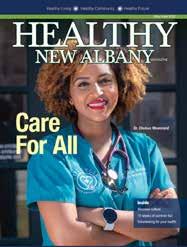





Now a Columbus resident with his wife and two kids, Doug Ulman is also a three-time cancer survivor and is involved in many cancer-related organizations, such as his co-founded Ulman Foundation and Pelotonia. He has previously served in many executive leadership roles at The LIVESTRONG Foundation, among others organizations, and has shared his story and message widely to raise awareness nationally.




He is an experienced speaker and interviewer, as a speaker at conferences such as Inc. 500 | 5000 Conference and TEDxAUSTIN and an interviewer at two Lecture Series presentations — with Dr. Sanjay Gupta about health and wellbeing in 2018 and Michael Phelps about mental health in 2021.
Robin Roberts, based in New York with her wife, is a two-time cancer survivor.
Her career as a journalist includes more than 20 years as a news anchor-turned-co-host on GMA, 15 years as a sportscaster with ESPN SportsCenter and more. Over the years, she has received numerous awards for sharing her health journey, including the 2017 People’s Choice Award for Favorite Daytime TV Hosting Team as well as the 2013 Arthur Ashe Courage Award at the ESPY’s.
She has worked with organizations such as Be The Match to encourage people to become bone marrow donors, and she uses her platform to share information and optimism around health topics as well as advocate for more equity in healthcare.


Want to know what is piquing the interest of homebuyers or what top designers and builders are investing in around central Ohio? Look no further than the Parade of Homes to experience firsthand what’s new in the home building and buying space. For more than 70 years, the Building Industry Association of Central Ohio (BIA) has presented the Parade of Homes featuring the top homes, developments and builders across central Ohio. This year’s parade highlights more than 15 builders showcasing their own unique style and innovative designs across several communities. From Diyani Homes in Powell to Epcon Communities in Plain City and beyond, these builders are showing off their capabilities with various aesthetics and layouts.

These designers will be showing off their best styles and innovation, displaying a variety of styles from farmhouse to contemporary, open concept to tradition-
al room layout. Look out for details from crown molding and wainscoting to countertop and backsplash combinations to the variations in tile between bathrooms
Save the Dates
Sept. 18-28
Thursdays-Sundays
Noon-6 p.m.
Throughout central Ohio

and other rooms, as well as overarching style of paint colors and floor tones for inspiration.
More than 40 homes will be on display across the communities, from single-family homes with spacious rooms to grow into to multi-family homes perfect to hold your whole family. Stop along the route after work to visit the top contenders in communities close by in Galena and Sunbury, or take a weekend drive around I-270 to visit the various homes from Dublin to Grove City to Reynoldsburg. Grove City is one example of a perfect spot for viewing these builders at work, as past Parade of Homes Featured Community of 2022 Beulah Park will be showcasing a four-bedroom, open concept farmhouse style from PNE Homes and a five-bedroom, recreational spaceaplenty home from 3 Pillar Homes.
The Parade of Homes is taking place from Sept. 18-28, Thursdays through Sunday. Find your opportunity to revel in the new developments and innovations in home design today, and take note for your next project. Who knows? You might just find your next home along the way.
Jane Dimel is an assistant editor at CityScene Media Group. Feedback welcome at jdimel@cityscenemediagroup.com.



October 12, 2025 - 3:00 p.m.
October 12, 2025 - 3:00 McCoy Center McCoy Center








Healthy New Albany’s community-centered approach to Breast Cancer Awareness Month

According to the World Health Organization, breast cancer is the most common cancer among women worldwide and the leading cause of cancer-related deaths among women globally. In the U.S., the American Cancer Society estimates that one in eight women will face a breast cancer diagnosis in her lifetime.
Behind these statistics are real people, real families and real communities. This October, Healthy New Albany is creating space for those stories while offering tools that empower people to better understand risk, support one another and make informed choices around prevention and care.
As part of Breast Cancer Awareness Month, Healthy New Albany will offer two public programs designed to educate, uplift and connect. These events take
a whole-person approach to wellness, blending lived experience with practical, evidence-based knowledge.
community conversation on breast cancer, healing and hope
Mon., Oct. 6 | 6 p.m. | Philip Heit
Center for Healthy New Albany
At the heart of the month’s programming is a special panel discussion featuring four local breast cancer survivors: Deniece Pittman, Adriana De la Peña Driottz, Amy Cobbs and Angie Cox. In an open, heartfelt conversation moderated by Dr. Shilpa Padia, MD, a fellowship-trained, boardcertified surgical oncologist with Mount Carmel Health System, each panelist will share their experience navigating diagnosis, treatment and life beyond cancer.
Padia will offer clinical insight and help guide a meaningful audience dialogue around topics such as early detection, treatment decisions, survivorship and emotional care. With expertise in both male and female breast cancer, hereditary risk factors, oncoplastic reconstruction and nipple-sparing mastectomies, she brings a well-rounded perspective that connects personal experience with medical understanding.
This program is not a traditional health talk lecture. It’s a chance to listen, reflect and witness the strength within our community. For attendees, it’s also an opportunity to ask questions, learn from others and feel less alone. Creating space for these conversations helps reduce stigma, normalize dialogue around breast cancer and reinforce the message that no one should have to face a diagnosis in isolation.

The American Cancer Society estimates that only about five to 10 percent of breast cancers are hereditary. The majority of cases occur in women with no specific risk factor aside from being female and growing older. That’s why public awareness efforts such as Stories of Strength are so important. Early detection saves lives, but people need knowledge, access and encouragement to seek care.
Nourish to Flourish: Cooking with ingredients that support healing and prevention Sun., Oct. 26 | 2 p.m. | Philip Heit Center for Healthy New Albany Teaching Kitchen
The second event of the month takes a practical and hands-on look at prevention through nutrition. In this special Nourish class, participants will explore the role food can play in supporting immune health and reducing chronic inflammation, a known risk factor in the development of many diseases, including cancer.
Led by culinary professional Sharon Dunn and functional nutritionist Pamela Conn, the class combines science-based instruction with approachable recipes. Participants will prepare and enjoy flavorful meals using ingredients selected for their anti-inflammatory and immune-
supportive properties. As they cook, they’ll learn why these choices matter and how to carry them into daily life.
This class is part of Healthy New Albany’s ongoing Nourish program, which promotes food as a foundation for



lifelong wellness. And while eating well can’t eliminate all cancer risk, decades of research show that healthier lifestyle choices can lower cancer risk as well as
that of other chronic diseases and help people live a longer and healthier life.
According to the American Institute for Cancer Research, regular physical


activity, a balanced diet, maintaining a healthy weight and avoiding alcohol are among the most impactful habits for longterm breast health.
Stories of Strength and Nourish to Flourish reflect what Healthy New Albany does year-round: bring people together to learn, connect and support one another in health.
“October shines a spotlight on breast cancer, but the fight for awareness and support is a year-round commitment,” says Healthy New Albany Executive Director Rachel Haugk. “Through collaboration with our community partners, we aim to amplify this important message and make a real impact on early detection.”
These programs are part of a broader initiative in collaboration with the New Albany Community Foundation. By bringing national voices such as Robin Roberts to the stage via The New Albany Lecture Series and partnering with local health pillars such as The James and Pelotonia, the Foundation is helping to turn awareness into action.
Together, we are creating opportunities to build a healthier, more connected community.

By Elizabeth Cullinan, Librarian at the New Albany branch of the Columbus Metropolitan Library

By Kelly Starrett and Juliet Starrett, 2023
From elite athletes to the everyday individual, mobility and movement become even more important as people age. In response, the authors of this book offer a 10-step guide to incorporating movement habits into daily activity. This approach emphasizes simple practices that enhance areas of movement, breathing, nutrition and sleep with the end goal of helping individuals optimize their overall physical well-being. Readers will find many actionable strategies that help make movement and wellness accessible to all.

By Nita Sweeney, 2022
This book brings together meditation and movement as a means for healthier living. Drawing insight from centuriesold traditions, it encourages readers to incorporate mindfulness practices into routine activities, such as walking, stretching or even washing dishes, and emphasizes making movement an intentional experience. The outcome for readers is a deeper understanding of themselves and a greater ability to find inner peace no matter the situation.

By Caroline Williams, 2022
Humans are designed to move, but we spend the majority of our time sitting still, and this is severely hurting our health. However, it doesn’t require a lot to change that. Backed with scientific research and offering practical daily strategies, this book aims to connect mental health and physical movement. It offers insight into how readers can use simple movements to enhance brain function, reduce stress and improve overall happiness.

By Katy Bowman, 2021
With the abundance of modern conveniences and continual enhancement of technology, engagement with physical and nature-rich activities, especially for children, is rapidly declining. However, adding more movement into daily activity can be simple and fun for the whole family. Acting as both an educational resource and a field guide, this book offers families practical inspiration on how to engage more with outdoor experiences and find more opportunities for movement filled environments within their own home.
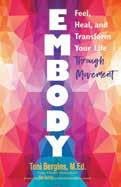

By Toni Bergins, M.Ed., 2024
This book offers a new approach to healing by connecting movement with trauma recovery. Readers will be introduced to practices that emphasize releasing emotional burdens by reconnecting with the body through expressive movement, guided imagery and creative rituals. This approach to embracing physical movement will leave readers feeling uplifted in a way that is accessible and deeply impactful.
By Kelly McGonigal, Ph.D., 2019
Exercise is often looked at as a chore needing to be done, but it can and should be a source of joy. Through a blending of scientific research and inspiring real-life stories, this book focuses on how movement is interconnected to things such as self-expression, resilience and social connection. It’s also found to be a vital piece in the quest to combat depression, strengthen communities and enhance well-being. Ultimately, readers will find this book reframes movement not just as a means for exercise but as a powerful tool for personal growth.
























In June 2025, home prices in New Albany were up by about 12.3 percent compared to last year. Homes sold for a median price of $870,000 after an average of 36 days on the market which is down from an average of 50 days last year. A total of 16 homes were sold June this compared to 25 the previous year. (Data from Redfin)
All information is collected from the Franklin County Auditor’s Office.
3818 Purdey Ct.
5 beds, 4.5 baths
$3,250,000
Sold 7/29/25
2 Albery Lp.
5 beds, 7 baths
$3,200,000
Sold 6/27/25
20 Wiveliscombe
5 beds, 6 baths
$2,650,000
Sold 6/6/25
4477 Ackerly Farm Rd.
5 beds, 6 baths
$1,598,000
Sold 7/17/25
4086 Sedgwick Dr.
7 beds, 5.5 baths
$1,380,000
Sold 6/12/25
4 Alban Mews
3 beds, 4.5 baths
$1,340,000
Sold 6/27/25
7375 Southfield Rd.
4 beds, 4.5 baths
$1,300,000
Sold 7/9/25
7833 Calverton Sq.
6 beds, 6.5 baths
$1,200,000
Sold 7/25/25
18 Pickett Pl.
4 beds, 4.5 baths
$1,200,000
Sold 6/27/25
4454 Middle Aspinwall
4 beds, 3.5 baths
$1,140,000
Sold 6/27/25
3976 Weston
4 beds, 3.5 baths
$1,050,000
Sold 6/13/25
7310 Britts Bend W.
4 beds, 4 baths
$895,000
Sold 7/17/25


6983 Hanby’s Loop |

Lauren Davie 740-975-1826
LaurenDavieRealtor.com
$2,799,000, 5 Bedrooms, 5 Bathrooms, 6,261 sq ft
A like-new custom-built home in the prestigious Ebrington neighborhood overlooking the scenic West 7th hole of the New Albany Country Club golf course. Highlights include soaring 12 and 17ft ceilings, a chef’s kitchen, rich custom Amish cabinetry through-out, a luxurious first-floor primary suite with spa-like bath, expansive indoor-outdoor living spaces, and a fully finished lower level with a theater, custom bar, and guest suite. Lauren.davie@evrealestate.com


7130 Sumption Dr, New Albany | $664,900


Jean M. Lesnick (614) 537-5376
jeanl@newalbanyrealty.com
Beautifully maintained seven-bedroom home with five full baths facing the NACC golf course. Walking distance to the club and golf pavilion. Full lower level with extensive family room/rec room, bar area, bedroom, full bath, and storage. Featuring a generator, 2-zoned HVAC system, newer roof, upgraded light fixtures, a Wolf range, a Sub Zero refrigerator, and more. $1,380,000. NEW ALBANY REALTY www.WelcometoNewAlbany.com
915-4588
Charming New Albany Schools home with full front porch, tiled patio, and private, treelined yard. Chef’s kitchen boasts granite counters, island, pantry, new SS appliances, and ample cabinetry. The two-story great room offers a cozy fireplace. Vaulted owner’s suite includes a spa-like bath and walk-in closet. 3 additional BRs, finished LL with wet bar, and egress windows. Updates include roof, HVAC, garage doors, paint, lighting, and carpet. COLDWELL BANKER REALTY ThePowellBuehlerGroup.com


(614) 915-4588
10019 Duncan Plains Rd, Johnstown | $375,000
This 2.61-acre parcel offers endless potential in a rapidly developing area. Just minutes from retail, restaurants, and key transportation routes, this property is ideally situated for residential, commercial, or mixed-use development (subject to zoning). Don’t miss your chance to invest in one of Central Ohio’s hottest growth corridors! Johnstown School District!
COLDWELL BANKER REALTY ThePowellBuehlerGroup.com




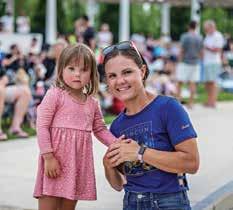
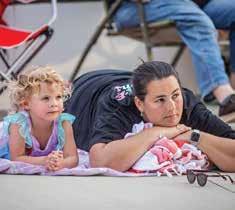




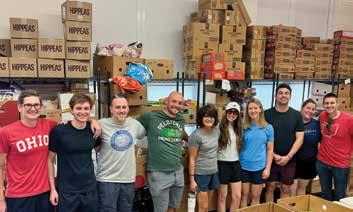




Low Wait Times. Expert Care.
